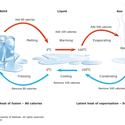The minerals found in human teeth and bones that give them their hardness and strength belong to a group of minerals called biological apatites.
The apatites found in bone, tooth enamel and tooth dentine have slightly different compositions and therefore have different physical and mechanical properties.
The biological apatites are forms of calcium hydroxyapatite, which has the formula Ca10(PO4)6(OH)2.
Bioceramics based on bovine hydroxyapatite have been developed and are used in some forms of dental implants. Research into their use as a bone repair material is ongoing.
Tooth enamel
Tooth enamel is the hardest and most highly mineralised substance in the body. It is 96% mineral, with water and protein accounting for the other 4%. This high mineral content gives it strength and hardness, but also brittleness.
Tooth enamel can undergo a process called demineralisation if the pH of the mouth falls to lower than normal levels. The combination of mouth bacteria and sugars from some foods, snacks, soft drinks and sweets can generate lactic acid. The acidic conditions over time cause the enamel to slowly dissolve, creating tooth cavities. This allows for greater bacterial invasion deeper into the tooth, which assists the decay process.
| Ca10(PO4)6(OH)2(s) | +
| 8H(aq) | →
| 10Ca2+(aq) | + | 6HPO42-(aq) | + | 2H2O(l) |
| hydroxyapatite | acid | mineral slowly dissolves | ||||||
Tooth enamel and fluoride
The presence of fluoride either in drinking water or in toothpastes has greatly reduced the incidence of tooth decay in the population.
Fluoride speeds up the movement of calcium and phosphate into the tooth surface. This remineralises the crystalline structures in a dental cavity. The remineralised tooth surfaces contain fluoridated hydroxyapatite and fluorapatite, which resist acid attack much better than the original tooth did.
| Ca10(PO4)6(OH)2(s) | + | 2F(aq) | → | Ca10(PO46(F)2(s) | + | 2OH-(aq) |
| hydroxyapatite | fluoride | fluoroapatite | ||||
Fluoridation is a socio-scientific issue as explained in the article Water fluoridation – a socio-scientific issue.
Dentine
Dentine is found just under the enamel in the crown of the tooth and under the cementum in the root. It determines the size and shape of tooth.
Like enamel, it is a hydroxyapatite, but with a slightly different composition. The unique structure and composition of dentin allows it to function as the substructure for rigid enamel tissue. This provides teeth with the ability to flex and absorb tremendous forces without fracturing.
Bone
Bone is a specialised form of connective tissue. It is composed of cells embedded in a mineralised mixture of collagen fibres, bone proteins and carbohydrate-based chemicals called glycans.
In the hard outer layer of bone, called compact bone, the mineralised mixture is full of small channels, some of which (known as Haversian canals) carry blood vessels and nerves. Other smaller channels allow materials to be moved to and from the bone cells.
This unique arrangement allows minerals like hydroxyapatite to be deposited and stored, giving bone its strength.
Most of the calcium stored in the body is in bone tissue. This can be released into the blood according to the demands of the body or can be used to produce new bone.
Bone is a dynamic tissue that is continually being formed and broken down. This remodelling and reorganisation of bone tissue is dependent on many factors, including:
- exercise
- ageing, illness, lack of calcium in the diet
- hormonal changes
- effects of drugs.
Activity ideas
Bone minerals – investigate how bone strength varies with its mineral content and the solubility of bone minerals in neutral and acidic solutions.
Bone strength – create artificial bones made of paper to compare the relative strength of solid bones with hollow bones.






